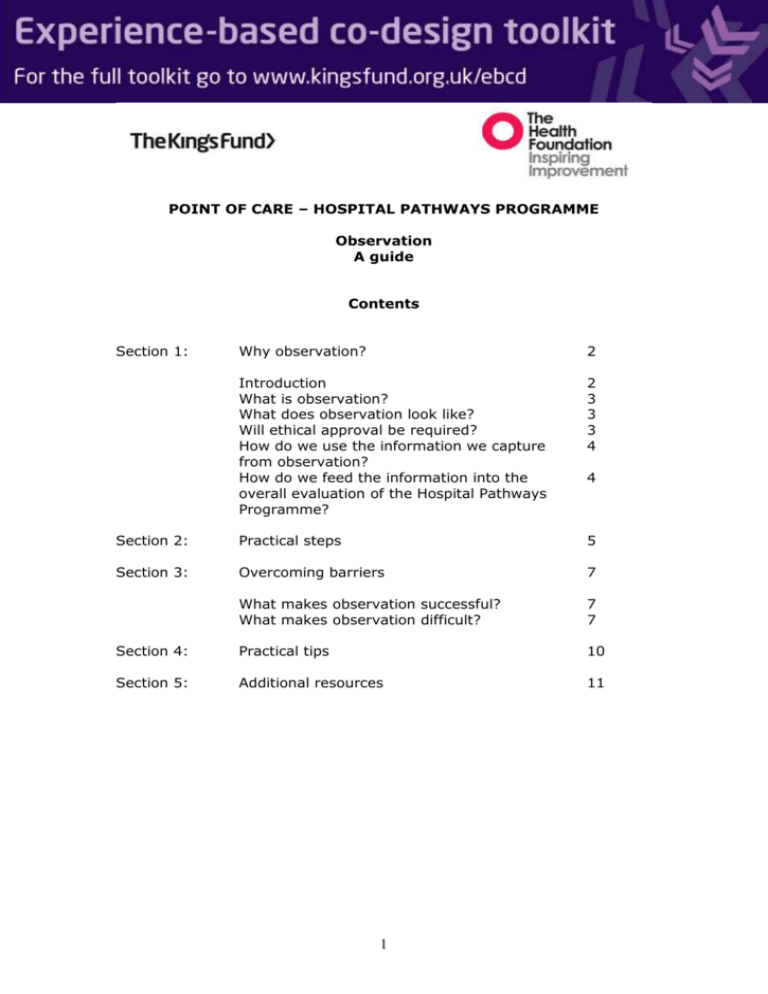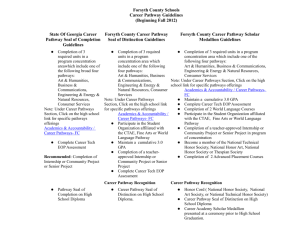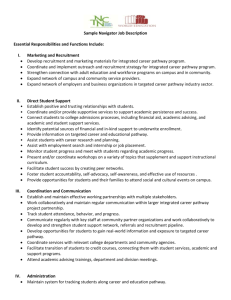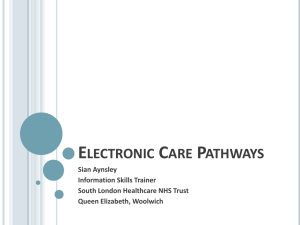The Point of Care - Hospital Pathways programme: observations guide
advertisement

POINT OF CARE – HOSPITAL PATHWAYS PROGRAMME Observation A guide Contents Section 1: Why observation? 2 Introduction What is observation? What does observation look like? Will ethical approval be required? How do we use the information we capture from observation? How do we feed the information into the overall evaluation of the Hospital Pathways Programme? 2 3 3 3 4 Section 2: Practical steps 5 Section 3: Overcoming barriers 7 What makes observation successful? What makes observation difficult? 7 7 Section 4: Practical tips 10 Section 5: Additional resources 11 1 4 POINT OF CARE – HOSPITAL PATHWAYS PROGRAMME Observation A guide ‘Please can we avoid crass attempts at humour? There is nothing funny about clutching a plastic bag with all your clothes in, except your pants, socks, and shoes – just stop and think what that must be like – while trying to secure a hospital gown around you, and following, like some faithful gun dog, a radiology attendant who without introduction commands you, with a broad grin to acknowledge his witty lack of grammar, to "follow I!"’ ‘Please can all health care professionals stop asking patients to "Do this for me?" I’m not doing it for them, I’m doing it for me. The key point here is about locus of control. If I am asked, or more often instructed, to do something "for me" – meaning the health professional – then the locus of control for the transaction lies with that person. But the focus of the transaction should be me, the patient. Structured in that way, the "for me" defines the interaction as transactional – I am cared for – but not relational: one is left with the feeling that the professional does not care about me but does something to me.’ Professor Kieran Sweeney Professor Kieran Sweeney, a general practitioner, was diagnosed with malignant mesothelioma at age 57. He died at the end of 2009. BMJ 2009;339:b2862 SECTION 1: WHY OBSERVATION? Introduction It is sometimes easy to forget that although the treatment of a disease may be entirely impersonal, the care of the patient must always be completely personal. Sometimes we become so accustomed to seeing the same things happening around us, we fail to notice either the positive or the negative impact these things have on others. To walk in a patient’s shoes and to understand how day-to-day routines and behaviours may be detrimental to the patient’s well-being are key to the Hospital Pathways programme. By taking dedicated time out to stop, look and listen to what happens to a patient we can reflect on the care 2 process, the environment and the many human interactions the patient has with staff during their time in hospital. What is observation? As part of the pre-work phase of the programme, we are asking you to focus on two care pathways and understand where care systems and processes currently prevent staff from providing excellent care. Key to this is developing an understanding of what patients experience as they move along the pathway and through the hospital. One way to do this is through observation: using your senses to see what happens at key points of the patient’s journey and then recording what you thought and felt about what you saw, heard and smelt. This will involve looking at both transactional issues (processes of care) and relational issues (human interactions between staff and patients). Remember that: we are asking you to look for what is good as well as what could be done better we want you to think about each pathway from the patient’s perspective. the information you collect from observing will be used alongside other methods such as process mapping, interviews with staff, collection of data and patient shadowing to build a complete picture of what is happening and to help you design your ideal pathway. What does observation look like? Observation of practice may take the form of: sitting and watching what happens, eg, on a ward, in a waiting area, on an admission unit watching what happens as you walk through parts of the pathway or the whole pathway becoming a patient, eg, wearing a gown and being pushed on a trolley video recording parts of the pathway, eg, sitting and recording separate parts of the pathway, taking a camera with you as you pretend to be a patient. It is up to you which method(s) you use to observe. You need to find what works for you in your trust. For the pre-work phase, you may find that direct observation by staff will be the least time-consuming approach. Will ethical approval be required? Before you embark upon any form of observation activity, talk to your local research ethics committee about any local protocols that need to be followed. It will be able to advise you on, for example, whether patient consent is needed for video recording. 3 How do we use the information we capture from observation? As part of the pre-work stage, we are asking you to diagnose your current practice across two care pathways and to use the information you gather to design the ideal pathway. We would then like you to continue using this method to measure your progress against implementing your idealised design. As the programme progresses, you could think about observing against some of the primary drivers for improvement. How do we feed the information into the overall evaluation of the Hospital Pathways programme? As we are conducting a full evaluation of the Hospital Pathways programme, we would be grateful if you could compile all your observation records into a single file that can be looked at as a complete body of evidence at the end of the programme. 4 SECTION 2: PRACTICAL STEPS 1. Recruit your observers. Include both clinical and non-clinical staff to gain different perspectives. Taunton and Somerset NHS Trust has recently completed some observation using medical students. 2. Meet as a group to decide which parts of the care pathway you want to observe and in what format. 3. Decide where each observation will take place, how long it will last and when it will be carried out. 4. Decide who will carry out which observation. 5. Brainstorm what to look for in advance. This will give you a framework to work in and may be helpful for those who have not carried out observation before. However, don’t pre-judge what you might see – you may miss things – just talk about the things that you would like to know. 6. Draw up a proforma (observation sheet) for recording what you see, hear, smell and feel. Keep this simple. For example, on one side you could write what you saw/heard, on the other you could write what you thought about it. Don’t forget to record key information like name of observer, place of observation and start and finish times. Alternatively, or in addition to a more general observation, if you wish to focus on more specific aspects, you could think about the use of an existing observation tool. For example, the quality of interaction audit (QUIS) tool focuses on measuring the quality of interaction between staff, patients and visitors (see Section 5: Additional resources) and involves coding and rating what you see. 7. Carry out a short practice observation and discuss how it worked afterwards. This will give those who have not used observation before some experience. It will also give you the opportunity to tweak the method or the paperwork before you carry out the observation for real. 8. Carry out the observation. See Section 4: Practical tips for more information. 5 9. Meet as a group to discuss your general observations, to digest what you’ve seen and to plan your feedback. Discuss feedback with individual departments/wards, particularly if there are examples of poor practice to be fed back into the system. Decide how this will be done and by whom. It is important that less experienced staff members are given the support they need to deliver difficult messages. You might also like to consider using a facilitator, who has not been involved in the observation and is a fresh, neutral pair of eyes, to help the team pull the information together and plan the feedback. 10. Give feedback to those you have observed. Keep comments constructive and encourage discussion of findings. Think about how you would like feedback to be delivered if you were the observed rather than the observer. Concentrate on what you saw/heard and how it made you feel. 11. Collate, analyse and interpret the data collected. It may be helpful to allocate one person to sort the information from all the observation sheets. Think about sorting the information into general themes, with key points under each, for each part of the pathway observed. Some general points for the pathway as a whole may emerge from the analysis. If you are using a specific observation tool, this is likely to contain information on rating, scoring and interpretation. Bring the team working on the pathway together to discuss the findings and how they will feed into both the diagnosis of current practice and the design of your ideal pathway. When looking at the output from your observations remember to look for what works well from the patient’s point of view (and should therefore be retained) and what works less well (and should therefore be changed). From your discussions, you’ll be able to see if you’ve gathered enough information to see where the care pathway is working well and where it needs to change. Carry out more observation if you need to. 6 SECTION 3: OVERCOMING BARRIERS What makes observation successful? It is important to go into an observation without pre-conceptions. Try to imagine that you are a stranger to the trust and visiting for the first time. Be neutral, absorb yourself in the situation and watch and listen to everything around you. If you react emotionally to something you don’t like, try not to let this influence how you feel about the rest of the observation. You may find it useful for your team of observers to view a video at the address below which illustrates how easy it is to miss things that matter if you focus too narrowly: http://viscog.beckman.illinois.edu/flashmovie/15.php What makes observation difficult? To carry out observation successfully, it is helpful to think about some of the obstacles you might face when trying to carry out any form of observation. Barrier 1 If people asked to carry out an observation cannot see a value in doing it, it may not happen. Think about: collecting practical examples of where observation activity has made a difference to patient experience elsewhere (particularly in your own trust) inviting other staff in the trust to talk about their experiences of where observation has had an impact and made a difference explaining that observation is not being used to judge or audit performance but being used to understand what happens using people who are interested in the project and have a genuine curiosity about everyday practice and what the pathway is like for a patient carrying out a practice run to demonstrate what can be achieved. Barrier 2 If the approach you choose to take is too complicated, it may not happen. Think about: keeping it simple, straightforward and quick giving people the opportunity to input into the method of observation to be used doing as much preparation up front as possible. Make it easy for your observers by planning what needs to be done in advance. Where necessary, this should include seeking advice from the local research ethics committee about any local protocols to follow. 7 Barrier 3 Clinical staff, particularly more junior staff, may find it difficult to just watch what is going on around them without feeling pressure to stop observing and get back to doing, particularly when observing in their own clinical area. This pressure can be self-generated or can come from colleagues. Think about: staff not observing in clinical areas in which they work staff wearing their own clothes when they observe (check out infection control issues first) staff being given formal protected time to carry out the observation keeping the observation periods short, eg, 20–30 minutes. Barrier 4 Staff may feel unconfident and uncomfortable about carrying out observation if they have had little prior experience and are being asked to observe their colleagues/more senior staff. Think about: meeting as a team of observers at the start to discuss the process making it as easy for staff as possible by preparing in advance and planning for things that might happen carrying out a practice run and discussing how it worked observing in someone else’s department. Barrier 5 Staff may challenge the value of the process and refuse to be observed. Think about: discussing examples of where observation activity has made a difference to patient experience elsewhere explaining that the purpose of the observation is to gain information in order to improve patient experience, not to evaluate or judge explaining that findings shouldn’t be a surprise and are likely to confirm and validate what people already feel explaining that the findings will be discussed with those in the area being observed and people will be given an opportunity to comment and feed into the improvement process. 8 Barrier 6 Staff may feel uncomfortable carrying out observation in case they come across examples of poor or unsafe practice. Think about: drawing up guidelines on reporting bad practice and discussing them in advance with the observers discussing the actions to be taken if unsafe practice requiring immediate attention is seen providing staff, particularly more junior or less experienced staff, with support to feed their findings into the system. 9 SECTION 4: PRACTICAL TIPS Here are some things that you might like to consider when you are planning your observations. Carry out the observation in pairs – either at the same time or a few hours or days apart. Don’t talk about your findings until you have both finished. Observe at different times of the day and night, eg, early morning, late evening, lunch or supper time. Keep your observations relatively short, eg, 20–30 minutes. Think about observing in your own clothes (as long as there are no infection control issues). Decide on a form of words to introduce the observation to both patients and staff. Before the observation starts, make sure that staff know who you are, why you’re there and that, while observing, you will not usually be able to interact with them. Don’t observe where your presence might embarrass a patient. Position yourself in such a way that you can see what’s happening, avoid eye contact with anyone and stand or sit as still as possible. Make sure you have enough observation sheets with you to complete the observation (five or more will probably be enough). Make a note of the time you start observing and the time you finish (use an accurate watch – digital or with a second hand). Aim to observe as unobtrusively as you can – you don’t want to influence what is going on around you. If two observers are present at the same time, don’t talk to each other or distract each other. If you’re walking through the pathway be as quiet as possible, eg, wear soft-soled shoes, close doors quietly. If, at any time, the observation causes difficulties for a patient, withdraw. Do not intervene in the environment unless someone’s safety is directly threatened. Don’t look at things through the eyes of a patient. Instead, just focus on what you see and hear and then ask yourself afterwards what it must have felt like to be a patient experiencing those things. Try and suspend all judgements. Just watch and listen and think about what you’ve seen after the observation is over. Don’t write too much down at the time – you will remember what’s important. Write down your thoughts and feelings about what you saw and heard as soon as you have finished. At the end of the observation, put away any paperwork to signal that the observation is over. Where necessary, tell people the observation is over and thank them. Go over your handwritten notes at the end and check that they are legible and can be read and understood by other people. 10 SECTION 5: ADDITIONAL RESOURCES The NHS Institute for Innovation and Improvement has many materials to help you think about your approach to observation and gaining patient perspectives. See their website: www.institute.nhs.uk The quality of interaction audit (QUIS) tool has been developed by a nurse-led research collaboration with the Royal Free Hampstead NHS Trust, Barnet and Chase Farm Hospitals NHS Trust and City University. It evaluates the type and quality of communication that takes place on units, departments or wards. Contact your King’s Fund faculty member for further information. Acknowledgements We are grateful to the contributions from the following people in the compilation of this guide: Caroline Nicholson, Research Fellow, Care for Older Adults Research Team, St Bartholomew School of Nursing & Midwifery, City University. Liz Thiebe, Head of Programmes, Leadership Development, The King’s Fund. 11








